Financial Assets Investment Analysis Report: Lottery Win
VerifiedAdded on 2022/10/09
|7
|1494
|127
Report
AI Summary
This report analyzes the investment of a $10 million lottery win, focusing on three key financial assets: term deposits, equity, and derivatives. It details the major attributes of each asset, including interest rates, maturity periods, company stability, debt-to-equity ratios, earnings growth, counterparty risk, market risk, and liquidity risk. The report also discusses the investor's risk profile, considering factors like market demand and potential for investment errors. Based on this profile, a specific portfolio structure is proposed, allocating investments across real stock exchanges, real interest rates and banks, and derivative products. The portfolio allocation includes detailed calculations, demonstrating the potential returns and risks associated with each investment type. The report aims to provide a comprehensive guide to making informed financial decisions with a significant sum of money, offering strategies for maximizing returns while managing risk.
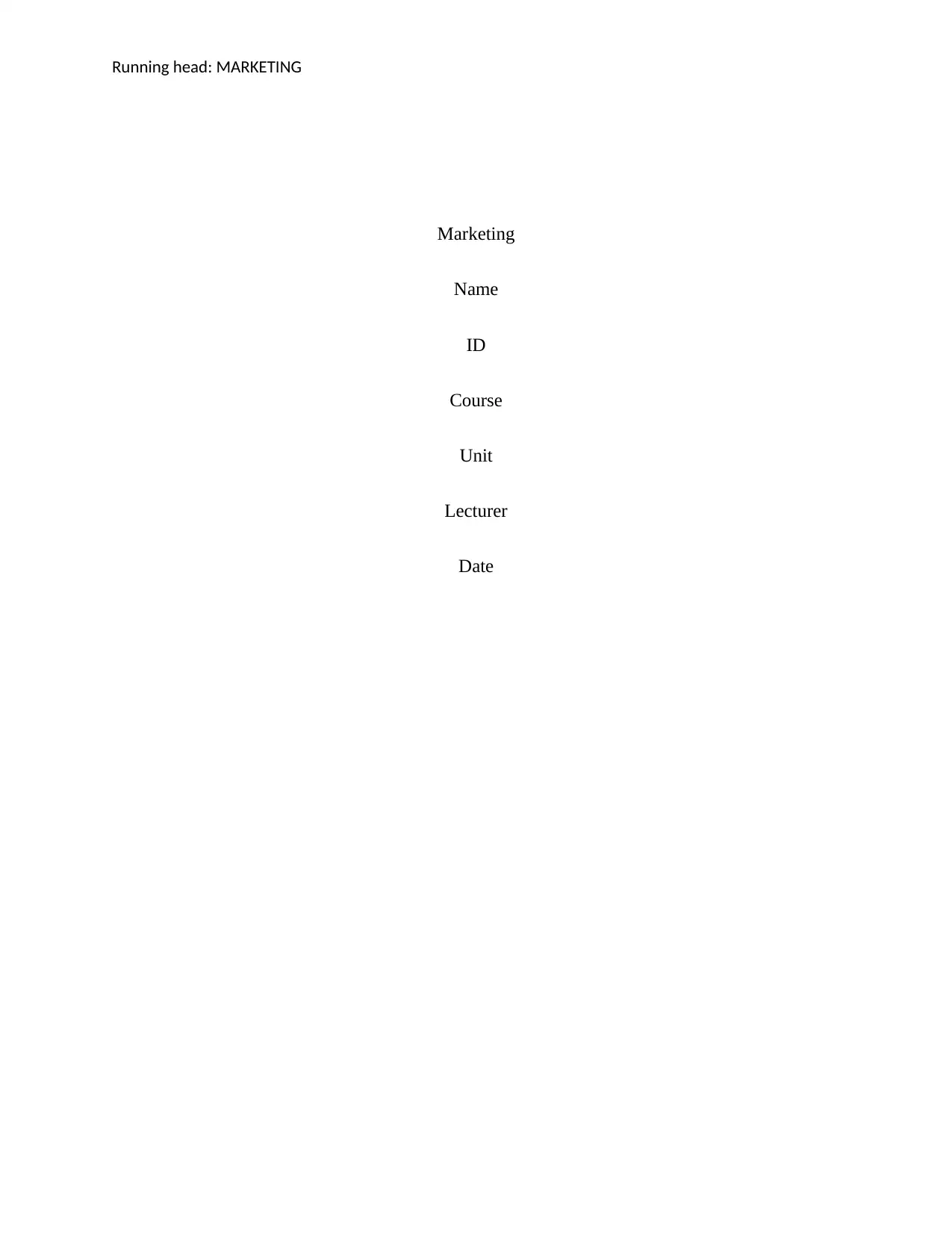
Running head: MARKETING
Marketing
Name
ID
Course
Unit
Lecturer
Date
Marketing
Name
ID
Course
Unit
Lecturer
Date
Paraphrase This Document
Need a fresh take? Get an instant paraphrase of this document with our AI Paraphraser
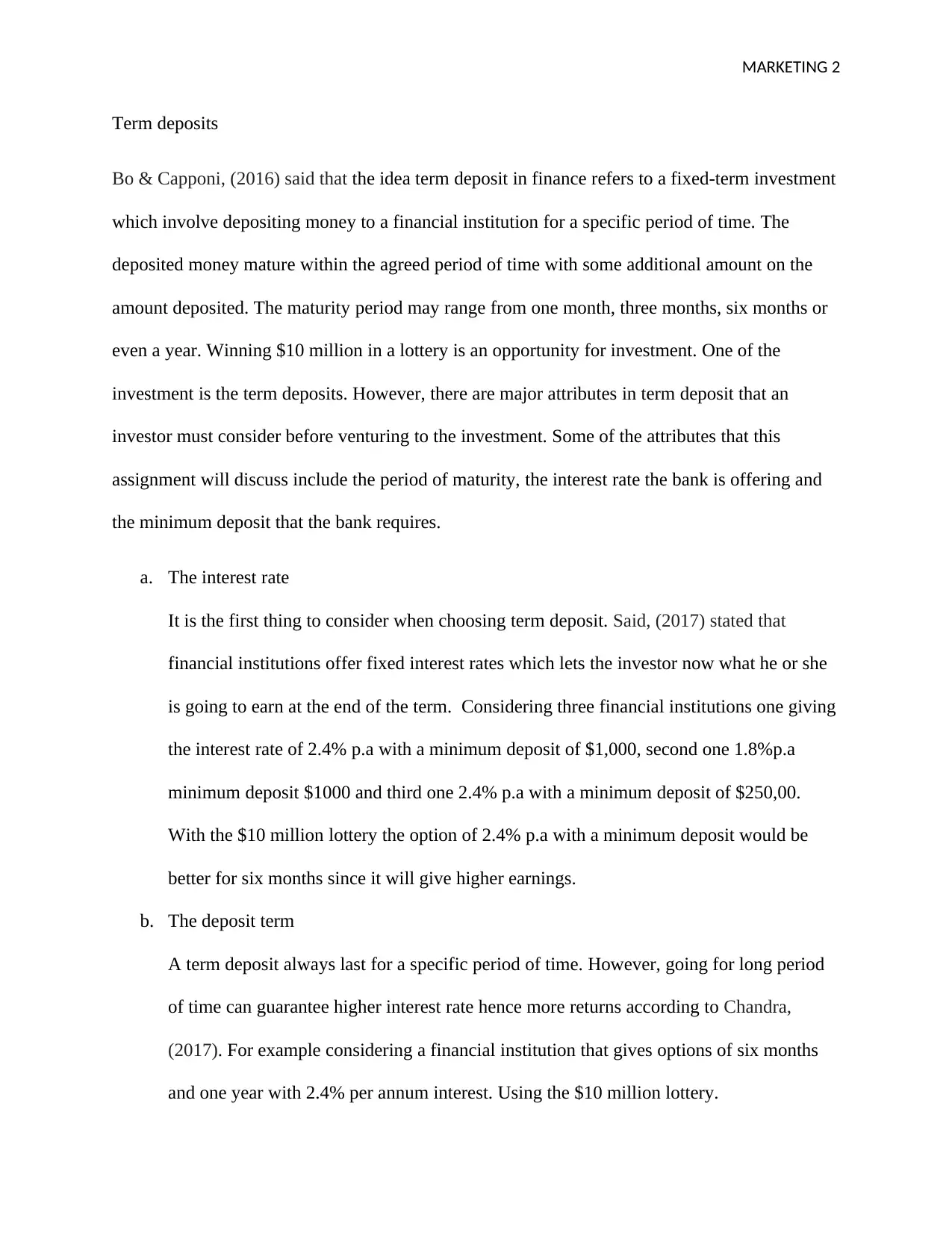
MARKETING 2
Term deposits
Bo & Capponi, (2016) said that the idea term deposit in finance refers to a fixed-term investment
which involve depositing money to a financial institution for a specific period of time. The
deposited money mature within the agreed period of time with some additional amount on the
amount deposited. The maturity period may range from one month, three months, six months or
even a year. Winning $10 million in a lottery is an opportunity for investment. One of the
investment is the term deposits. However, there are major attributes in term deposit that an
investor must consider before venturing to the investment. Some of the attributes that this
assignment will discuss include the period of maturity, the interest rate the bank is offering and
the minimum deposit that the bank requires.
a. The interest rate
It is the first thing to consider when choosing term deposit. Said, (2017) stated that
financial institutions offer fixed interest rates which lets the investor now what he or she
is going to earn at the end of the term. Considering three financial institutions one giving
the interest rate of 2.4% p.a with a minimum deposit of $1,000, second one 1.8%p.a
minimum deposit $1000 and third one 2.4% p.a with a minimum deposit of $250,00.
With the $10 million lottery the option of 2.4% p.a with a minimum deposit would be
better for six months since it will give higher earnings.
b. The deposit term
A term deposit always last for a specific period of time. However, going for long period
of time can guarantee higher interest rate hence more returns according to Chandra,
(2017). For example considering a financial institution that gives options of six months
and one year with 2.4% per annum interest. Using the $10 million lottery.
Term deposits
Bo & Capponi, (2016) said that the idea term deposit in finance refers to a fixed-term investment
which involve depositing money to a financial institution for a specific period of time. The
deposited money mature within the agreed period of time with some additional amount on the
amount deposited. The maturity period may range from one month, three months, six months or
even a year. Winning $10 million in a lottery is an opportunity for investment. One of the
investment is the term deposits. However, there are major attributes in term deposit that an
investor must consider before venturing to the investment. Some of the attributes that this
assignment will discuss include the period of maturity, the interest rate the bank is offering and
the minimum deposit that the bank requires.
a. The interest rate
It is the first thing to consider when choosing term deposit. Said, (2017) stated that
financial institutions offer fixed interest rates which lets the investor now what he or she
is going to earn at the end of the term. Considering three financial institutions one giving
the interest rate of 2.4% p.a with a minimum deposit of $1,000, second one 1.8%p.a
minimum deposit $1000 and third one 2.4% p.a with a minimum deposit of $250,00.
With the $10 million lottery the option of 2.4% p.a with a minimum deposit would be
better for six months since it will give higher earnings.
b. The deposit term
A term deposit always last for a specific period of time. However, going for long period
of time can guarantee higher interest rate hence more returns according to Chandra,
(2017). For example considering a financial institution that gives options of six months
and one year with 2.4% per annum interest. Using the $10 million lottery.
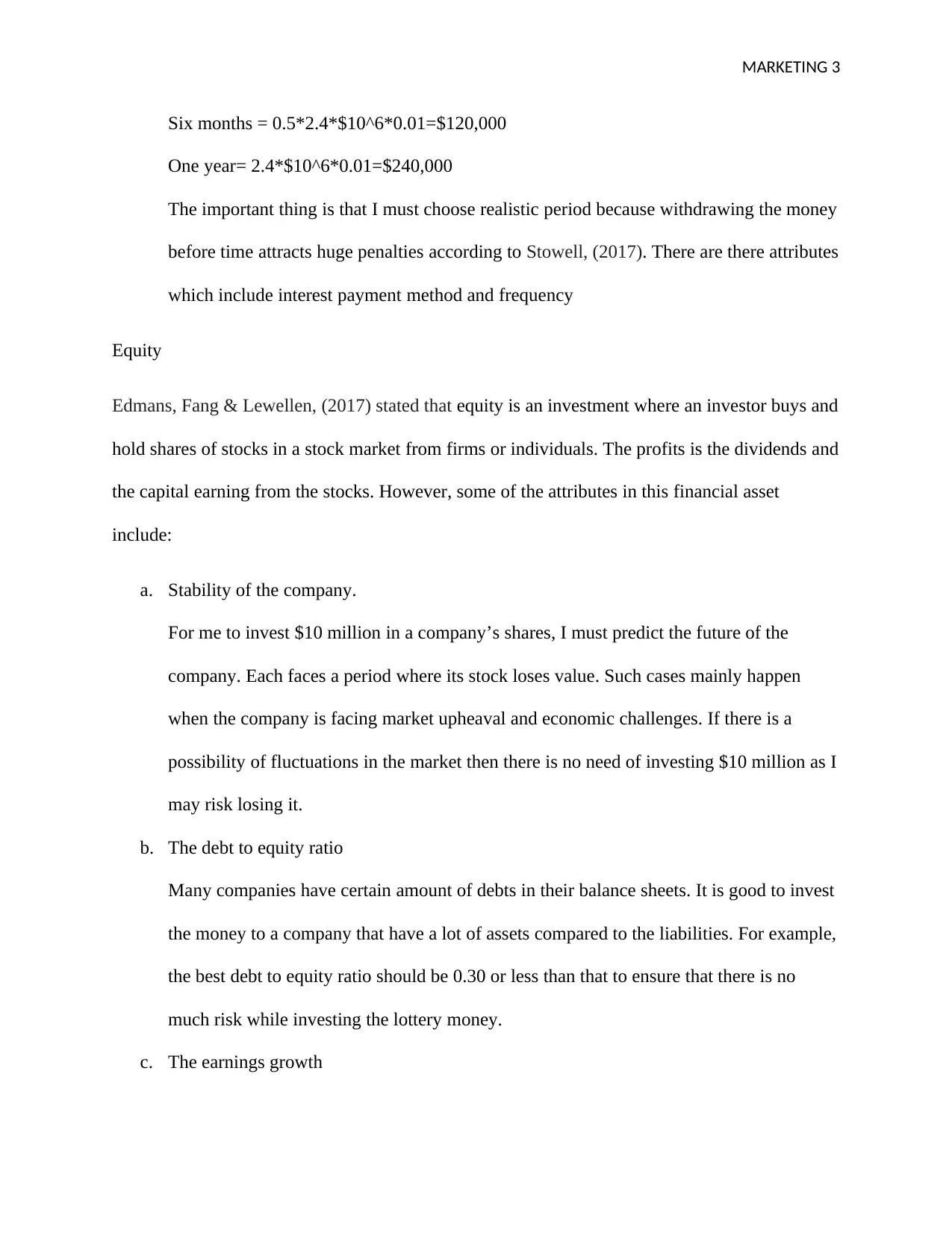
MARKETING 3
Six months = 0.5*2.4*$10^6*0.01=$120,000
One year= 2.4*$10^6*0.01=$240,000
The important thing is that I must choose realistic period because withdrawing the money
before time attracts huge penalties according to Stowell, (2017). There are there attributes
which include interest payment method and frequency
Equity
Edmans, Fang & Lewellen, (2017) stated that equity is an investment where an investor buys and
hold shares of stocks in a stock market from firms or individuals. The profits is the dividends and
the capital earning from the stocks. However, some of the attributes in this financial asset
include:
a. Stability of the company.
For me to invest $10 million in a company’s shares, I must predict the future of the
company. Each faces a period where its stock loses value. Such cases mainly happen
when the company is facing market upheaval and economic challenges. If there is a
possibility of fluctuations in the market then there is no need of investing $10 million as I
may risk losing it.
b. The debt to equity ratio
Many companies have certain amount of debts in their balance sheets. It is good to invest
the money to a company that have a lot of assets compared to the liabilities. For example,
the best debt to equity ratio should be 0.30 or less than that to ensure that there is no
much risk while investing the lottery money.
c. The earnings growth
Six months = 0.5*2.4*$10^6*0.01=$120,000
One year= 2.4*$10^6*0.01=$240,000
The important thing is that I must choose realistic period because withdrawing the money
before time attracts huge penalties according to Stowell, (2017). There are there attributes
which include interest payment method and frequency
Equity
Edmans, Fang & Lewellen, (2017) stated that equity is an investment where an investor buys and
hold shares of stocks in a stock market from firms or individuals. The profits is the dividends and
the capital earning from the stocks. However, some of the attributes in this financial asset
include:
a. Stability of the company.
For me to invest $10 million in a company’s shares, I must predict the future of the
company. Each faces a period where its stock loses value. Such cases mainly happen
when the company is facing market upheaval and economic challenges. If there is a
possibility of fluctuations in the market then there is no need of investing $10 million as I
may risk losing it.
b. The debt to equity ratio
Many companies have certain amount of debts in their balance sheets. It is good to invest
the money to a company that have a lot of assets compared to the liabilities. For example,
the best debt to equity ratio should be 0.30 or less than that to ensure that there is no
much risk while investing the lottery money.
c. The earnings growth
⊘ This is a preview!⊘
Do you want full access?
Subscribe today to unlock all pages.

Trusted by 1+ million students worldwide
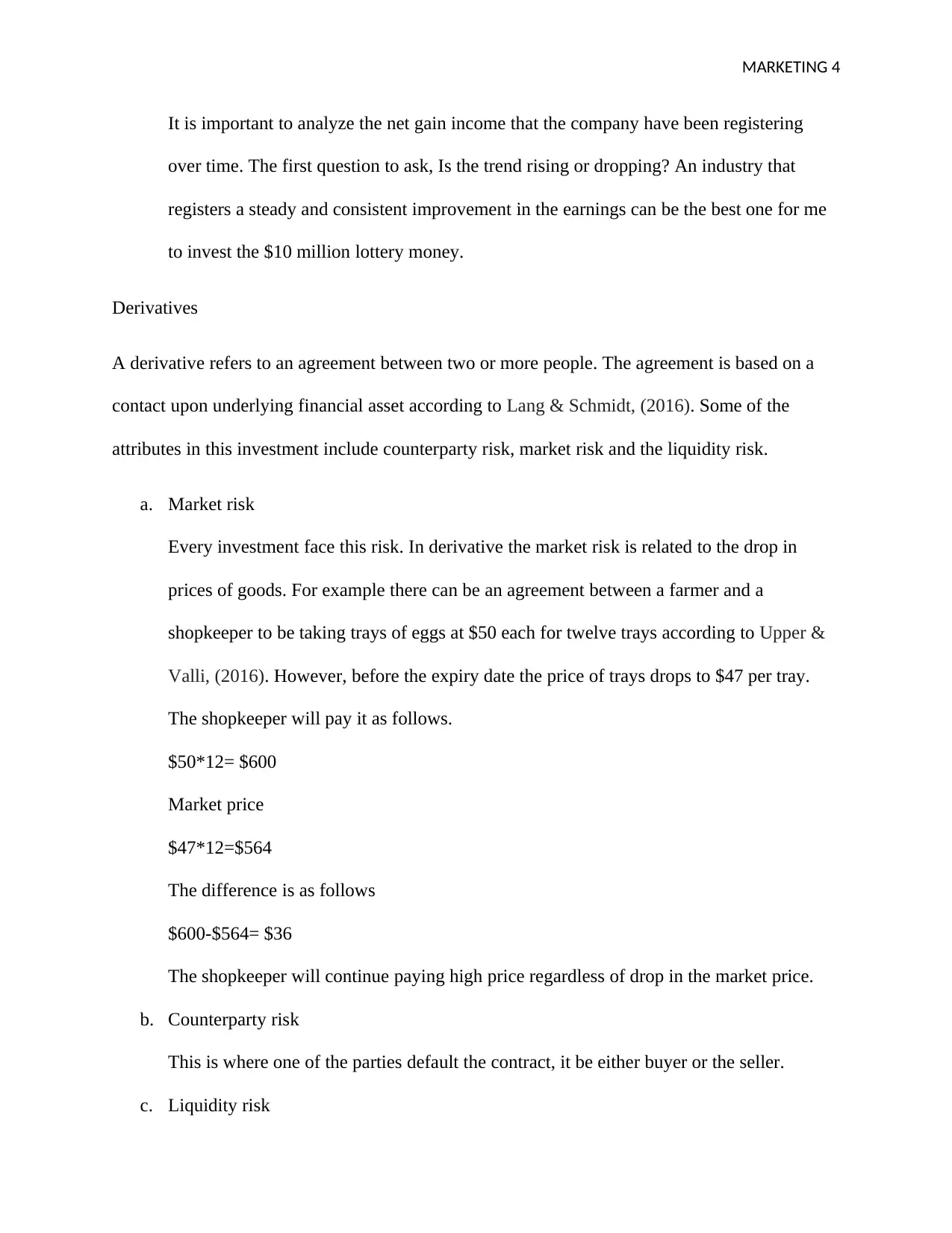
MARKETING 4
It is important to analyze the net gain income that the company have been registering
over time. The first question to ask, Is the trend rising or dropping? An industry that
registers a steady and consistent improvement in the earnings can be the best one for me
to invest the $10 million lottery money.
Derivatives
A derivative refers to an agreement between two or more people. The agreement is based on a
contact upon underlying financial asset according to Lang & Schmidt, (2016). Some of the
attributes in this investment include counterparty risk, market risk and the liquidity risk.
a. Market risk
Every investment face this risk. In derivative the market risk is related to the drop in
prices of goods. For example there can be an agreement between a farmer and a
shopkeeper to be taking trays of eggs at $50 each for twelve trays according to Upper &
Valli, (2016). However, before the expiry date the price of trays drops to $47 per tray.
The shopkeeper will pay it as follows.
$50*12= $600
Market price
$47*12=$564
The difference is as follows
$600-$564= $36
The shopkeeper will continue paying high price regardless of drop in the market price.
b. Counterparty risk
This is where one of the parties default the contract, it be either buyer or the seller.
c. Liquidity risk
It is important to analyze the net gain income that the company have been registering
over time. The first question to ask, Is the trend rising or dropping? An industry that
registers a steady and consistent improvement in the earnings can be the best one for me
to invest the $10 million lottery money.
Derivatives
A derivative refers to an agreement between two or more people. The agreement is based on a
contact upon underlying financial asset according to Lang & Schmidt, (2016). Some of the
attributes in this investment include counterparty risk, market risk and the liquidity risk.
a. Market risk
Every investment face this risk. In derivative the market risk is related to the drop in
prices of goods. For example there can be an agreement between a farmer and a
shopkeeper to be taking trays of eggs at $50 each for twelve trays according to Upper &
Valli, (2016). However, before the expiry date the price of trays drops to $47 per tray.
The shopkeeper will pay it as follows.
$50*12= $600
Market price
$47*12=$564
The difference is as follows
$600-$564= $36
The shopkeeper will continue paying high price regardless of drop in the market price.
b. Counterparty risk
This is where one of the parties default the contract, it be either buyer or the seller.
c. Liquidity risk
Paraphrase This Document
Need a fresh take? Get an instant paraphrase of this document with our AI Paraphraser
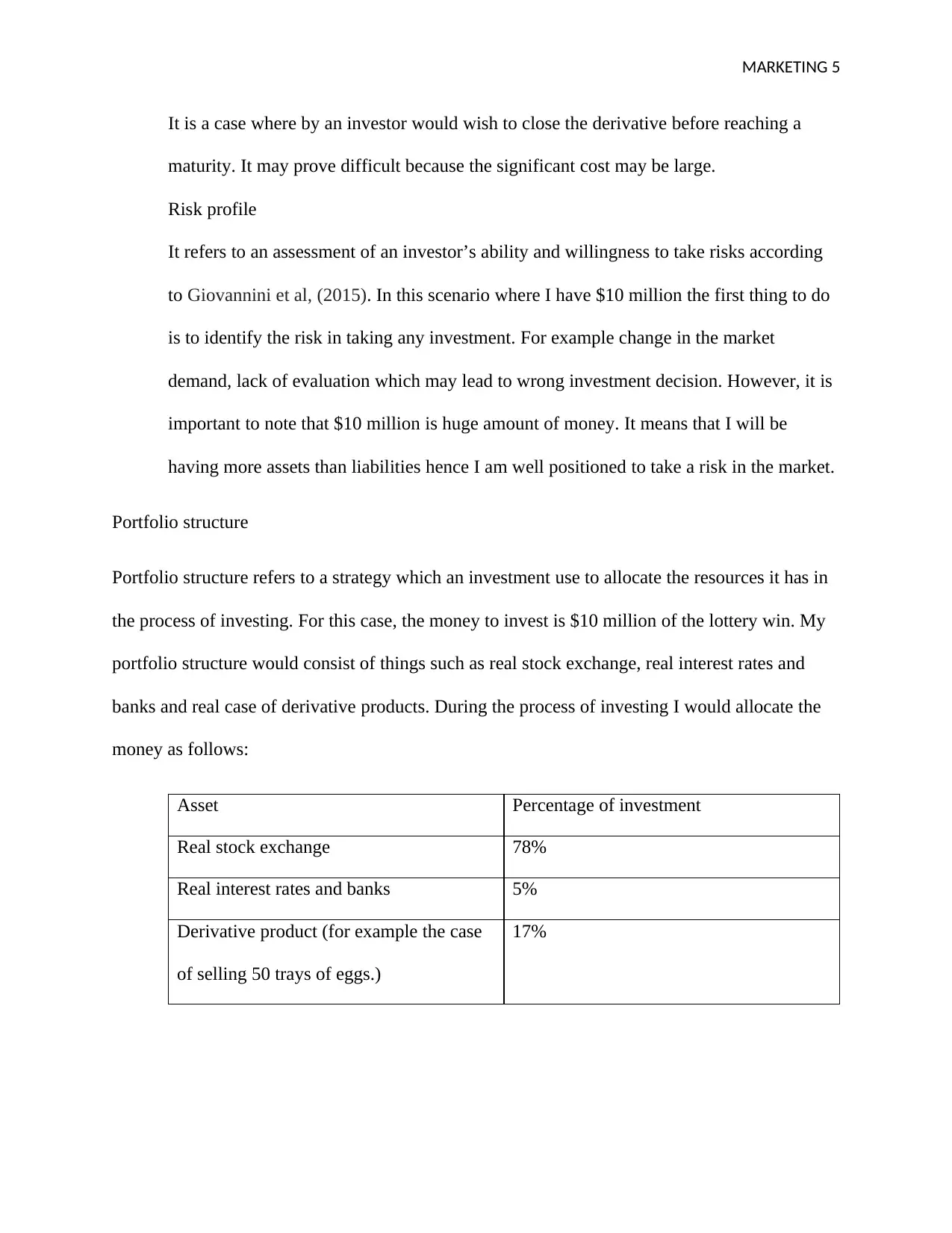
MARKETING 5
It is a case where by an investor would wish to close the derivative before reaching a
maturity. It may prove difficult because the significant cost may be large.
Risk profile
It refers to an assessment of an investor’s ability and willingness to take risks according
to Giovannini et al, (2015). In this scenario where I have $10 million the first thing to do
is to identify the risk in taking any investment. For example change in the market
demand, lack of evaluation which may lead to wrong investment decision. However, it is
important to note that $10 million is huge amount of money. It means that I will be
having more assets than liabilities hence I am well positioned to take a risk in the market.
Portfolio structure
Portfolio structure refers to a strategy which an investment use to allocate the resources it has in
the process of investing. For this case, the money to invest is $10 million of the lottery win. My
portfolio structure would consist of things such as real stock exchange, real interest rates and
banks and real case of derivative products. During the process of investing I would allocate the
money as follows:
Asset Percentage of investment
Real stock exchange 78%
Real interest rates and banks 5%
Derivative product (for example the case
of selling 50 trays of eggs.)
17%
It is a case where by an investor would wish to close the derivative before reaching a
maturity. It may prove difficult because the significant cost may be large.
Risk profile
It refers to an assessment of an investor’s ability and willingness to take risks according
to Giovannini et al, (2015). In this scenario where I have $10 million the first thing to do
is to identify the risk in taking any investment. For example change in the market
demand, lack of evaluation which may lead to wrong investment decision. However, it is
important to note that $10 million is huge amount of money. It means that I will be
having more assets than liabilities hence I am well positioned to take a risk in the market.
Portfolio structure
Portfolio structure refers to a strategy which an investment use to allocate the resources it has in
the process of investing. For this case, the money to invest is $10 million of the lottery win. My
portfolio structure would consist of things such as real stock exchange, real interest rates and
banks and real case of derivative products. During the process of investing I would allocate the
money as follows:
Asset Percentage of investment
Real stock exchange 78%
Real interest rates and banks 5%
Derivative product (for example the case
of selling 50 trays of eggs.)
17%
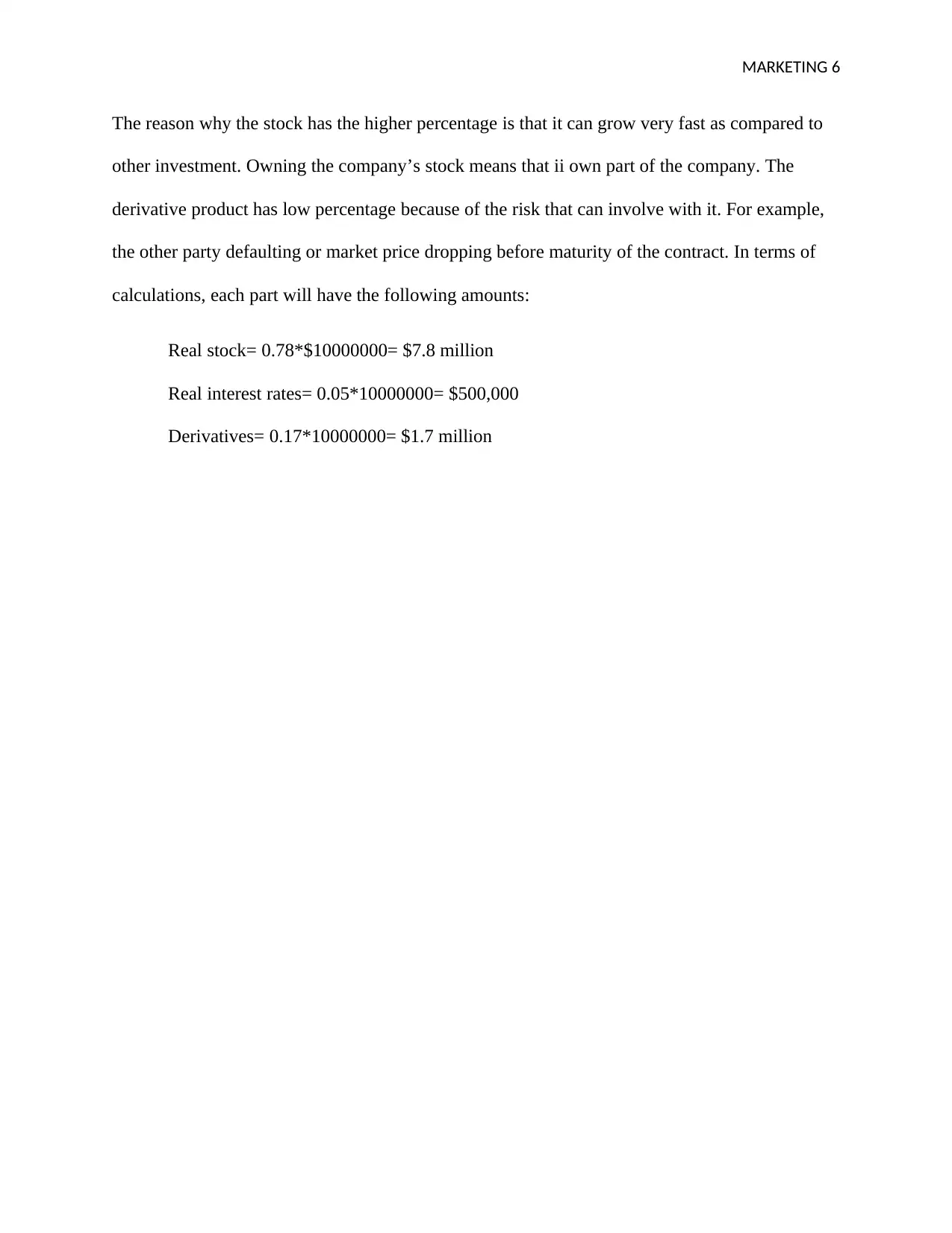
MARKETING 6
The reason why the stock has the higher percentage is that it can grow very fast as compared to
other investment. Owning the company’s stock means that ii own part of the company. The
derivative product has low percentage because of the risk that can involve with it. For example,
the other party defaulting or market price dropping before maturity of the contract. In terms of
calculations, each part will have the following amounts:
Real stock= 0.78*$10000000= $7.8 million
Real interest rates= 0.05*10000000= $500,000
Derivatives= 0.17*10000000= $1.7 million
The reason why the stock has the higher percentage is that it can grow very fast as compared to
other investment. Owning the company’s stock means that ii own part of the company. The
derivative product has low percentage because of the risk that can involve with it. For example,
the other party defaulting or market price dropping before maturity of the contract. In terms of
calculations, each part will have the following amounts:
Real stock= 0.78*$10000000= $7.8 million
Real interest rates= 0.05*10000000= $500,000
Derivatives= 0.17*10000000= $1.7 million
⊘ This is a preview!⊘
Do you want full access?
Subscribe today to unlock all pages.

Trusted by 1+ million students worldwide
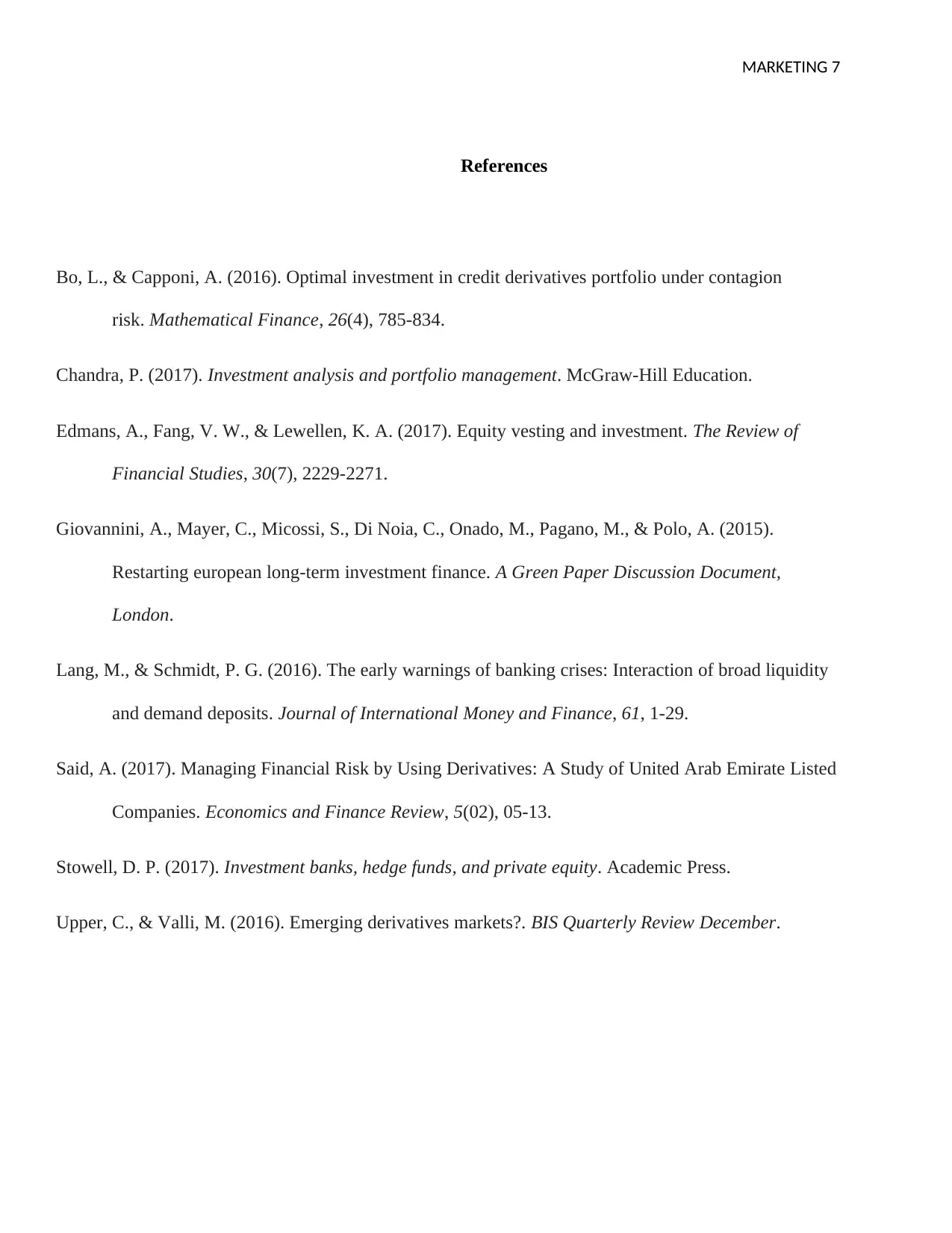
MARKETING 7
References
Bo, L., & Capponi, A. (2016). Optimal investment in credit derivatives portfolio under contagion
risk. Mathematical Finance, 26(4), 785-834.
Chandra, P. (2017). Investment analysis and portfolio management. McGraw-Hill Education.
Edmans, A., Fang, V. W., & Lewellen, K. A. (2017). Equity vesting and investment. The Review of
Financial Studies, 30(7), 2229-2271.
Giovannini, A., Mayer, C., Micossi, S., Di Noia, C., Onado, M., Pagano, M., & Polo, A. (2015).
Restarting european long-term investment finance. A Green Paper Discussion Document,
London.
Lang, M., & Schmidt, P. G. (2016). The early warnings of banking crises: Interaction of broad liquidity
and demand deposits. Journal of International Money and Finance, 61, 1-29.
Said, A. (2017). Managing Financial Risk by Using Derivatives: A Study of United Arab Emirate Listed
Companies. Economics and Finance Review, 5(02), 05-13.
Stowell, D. P. (2017). Investment banks, hedge funds, and private equity. Academic Press.
Upper, C., & Valli, M. (2016). Emerging derivatives markets?. BIS Quarterly Review December.
References
Bo, L., & Capponi, A. (2016). Optimal investment in credit derivatives portfolio under contagion
risk. Mathematical Finance, 26(4), 785-834.
Chandra, P. (2017). Investment analysis and portfolio management. McGraw-Hill Education.
Edmans, A., Fang, V. W., & Lewellen, K. A. (2017). Equity vesting and investment. The Review of
Financial Studies, 30(7), 2229-2271.
Giovannini, A., Mayer, C., Micossi, S., Di Noia, C., Onado, M., Pagano, M., & Polo, A. (2015).
Restarting european long-term investment finance. A Green Paper Discussion Document,
London.
Lang, M., & Schmidt, P. G. (2016). The early warnings of banking crises: Interaction of broad liquidity
and demand deposits. Journal of International Money and Finance, 61, 1-29.
Said, A. (2017). Managing Financial Risk by Using Derivatives: A Study of United Arab Emirate Listed
Companies. Economics and Finance Review, 5(02), 05-13.
Stowell, D. P. (2017). Investment banks, hedge funds, and private equity. Academic Press.
Upper, C., & Valli, M. (2016). Emerging derivatives markets?. BIS Quarterly Review December.
1 out of 7
Related Documents
Your All-in-One AI-Powered Toolkit for Academic Success.
+13062052269
info@desklib.com
Available 24*7 on WhatsApp / Email
![[object Object]](/_next/static/media/star-bottom.7253800d.svg)
Unlock your academic potential
Copyright © 2020–2025 A2Z Services. All Rights Reserved. Developed and managed by ZUCOL.




